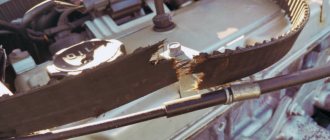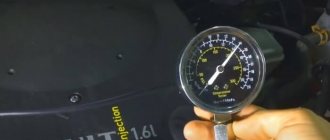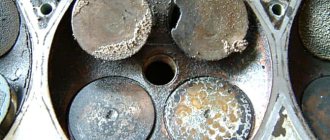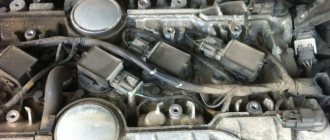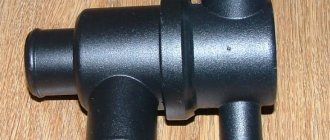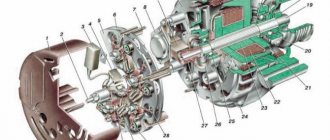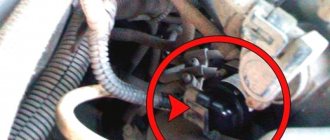A car engine is a complex unit, the performance of which directly depends on the proper operation of all components. At the same time, during the operation of the vehicle, the driver may encounter a loss of power, difficulty starting the engine, as well as an increase in fuel and engine oil consumption.
As a rule, a fairly common problem that is associated with engine wear and certain breakdowns is a decrease in compression. Low compression leads to the fact that the engine starts poorly, traction and power are lost, and there is excessive consumption of fuel and lubricant. Next we will talk about why compression in the engine disappears, as well as what the driver should do if the compression in the cylinders is low.
Does lack of pressure always indicate a malfunction?
Before considering the main causes and signs of this phenomenon, let’s figure out how this parameter affects the overall performance of the engine. If the pressure in the ICE lubrication system is below the standard calculated by the manufacturer, then practice shows that the ICE components will be excessively worn. But when it comes to compression, this is not always the case. When the rings on the pistons are mated with the cylinders, lubrication is very important - it collects on the cylinder walls. The oil seals the gaps between the rings and cylinders.
When not the entire volume of the combustible mixture burns in the cylinders, this will lead to high fuel consumption. If one or more spark plugs fail, the gasoline entering the combustion chamber will wash away the oil from the cylinder walls. This fuel is an excellent solvent. If there is no lubricant in the cylinder, if there is no pressure in the lubrication system, then the oil will no longer be able to sufficiently seal the gaps in the cylinder. Therefore, air under high pressure and gases formed during the combustion of the air-fuel mixture will enter the crankcase. This will lead to the fact that in a 4-, 6-, and 8-cylinder engine the compression will sharply decrease and then completely drop.
If the compression is at a level even higher than necessary, this will also cause increased oil consumption. Due to high oil compression, ring wear will occur more intensely. The gaps that inevitably form during engine operation are perfectly sealed with lubricant, of which there is a lot. In this case, urgent repairs are needed. However, in fact, compression will not show this problem.
How long will the engine last?
Low pressure is a problem that car enthusiasts often face. If the drop is insignificant, then the engine can be operated for a long time. But keep in mind that too little compression or its complete absence may be due to the strong heating of the unit.
Long-term operation of a car with an overheated internal combustion engine will eventually lead to its complete failure.
Detailed instructions for measuring pressure in engine cylinders are given below and filmed by the Made in Garage channel.
Signs of a problem or lack thereof
If there is no compression in one cylinder or in several, this can be determined by the following symptoms:
- Reduced pressure will be indicated by difficulty starting the engine. When trying to start, the driver will turn the flywheel with the starter much longer than usual. If the pressure disappears completely, starting will become almost impossible.
- An engine with low compression in one of the cylinders will triple and operate with less stability. Since there is no compression in one cylinder, the speed at idle will be unstable. This will also be reflected in the acceleration dynamics.
- Such an engine will certainly have increased fuel consumption. Determining this symptom is quite difficult for those who do not monitor this indicator. But for those who know the consumption for a certain mileage, the increase in engine appetite will be immediately noticeable.
- There will definitely be problems with the combustion chambers. When driving uphill, the hydraulic compensators may begin to knock. This will be especially noticeable and audible when driving at low speeds.
- In diesel power units, you can determine that there is no compression in one cylinder by characteristic popping sounds.
- Sometimes the pressure in the lines where the coolant circulates may increase. Due to low compression, antifreeze will be squeezed out from under the gaskets, from under the pipes and other seals.
- If compression is poor (if it is due to a broken cylinder head gasket), the tightness of the system is compromised. If you open the hood, you will see exhaust gases passing through the gap in the gasket. This malfunction leads to rings sticking on the pistons, which will contribute to increased oil and fuel consumption. In some cars, this symptom may be accompanied by an increase in power and the formation of white smoke from the exhaust pipe.
Level up on your own
Now we’ll tell you what to do to increase blood pressure. In garage conditions, it can be increased due to the formation of soot and deposits on the cylinders. All other faults can be resolved by dismantling the cylinder head and replacing damaged components. When removing the cylinder head, it will need to be bored, so it is better to entrust this process to specialists. How to increase the compression level:
- Prepare kerosene and alcohol. It is necessary to mix 25 g of each substance in a one to one ratio. One cylinder of the power unit will require 50 g of the resulting mixture. If you need to increase the pressure in several at once, then multiply 50 g by the number of elements.
- Start the vehicle engine. Let it warm up to operating temperature.
- Pour about 50 g of a mixture of kerosene and alcohol into the cylinders whose compression needs to be increased. The car should sit like this for about ten hours.
- After the time has passed, add about 20-30 grams of motor fluid and start the power unit. He needs to work for 20 minutes. With minor deposits on the engine walls, carbon deposits will be removed.
Non-mechanical damage
First, it is worth understanding the non-mechanical reasons that led to the lack of compression in a car internal combustion engine.
This includes various mistakes that a mechanic could make during the repair and assembly of the unit. If the motorist himself or specialists at the service station incorrectly set the timing marks or valve timing (and this often happens due to inattention), then the valves will not close when required by the operating principle of the internal combustion engine. During the compression stroke, the valves do not have time to close completely, because the phases are out of whack. As a result, some of the air will simply escape.
Sometimes non-mechanical compression problems can be caused by coked piston rings. This problem can later lead to valves sticking in the grooves. Gases will pass through easily since there are no seals.
In this case, if there is no compression in the 1st cylinder or any other, the oil scraper ring on the piston will not be able to perform its function, and the lubricant will also not be able to fill the gaps - it will be washed off the cylinder wall with unburned gasoline.
Methods for checking compression, causes of low compression. Motor repair or replacement?
Compression is the amount of maximum pressure in the cylinder created when the engine is idling with the starter (for example, when the spark plug is turned off). Engine compression should not be confused with the compression ratio, because these are different concepts.
Compression is a force exerted on a gaseous body, leading to a decrease in the volume it occupies, as well as an increase in pressure and temperature. In the broadest sense of the word, compression is the amount of pressure that is created in the cylinder at the end of the compression stroke.
When diagnosing malfunctions associated with interruptions in engine operation, the first step is to measure the compression. This will give you the right direction for further troubleshooting. You can improve the ignition and fuel supply as much as you like, but if the cylinder is not sealed enough, then it will not work normally. Timely compression measurements can detect cylinder depressurization in the early stages, thus saving money on repairs and time in troubleshooting.
Diesel engines are especially demanding on compression, since in them the fuel ignites without the use of a spark plug. In such an engine, a portion of fuel is injected through a nozzle into air heated from compression in the cylinder (to a temperature exceeding the ignition temperature of the fuel). As a result, if there is no decent compression, then there will be no conditions for ignition of diesel fuel.
During the injection of the fuel mixture, it is atomized, and then combustion centers appear around individual droplets of the fuel mixture; as the fuel mixture is injected, it burns in the form of a torch.
Since diesel engines are not subject to the phenomenon of detonation characteristic of engines with forced ignition, they can use higher compression ratios (up to 26), which, in combination with long combustion, ensuring constant operating pressure, has a beneficial effect on the efficiency of this type of engine , which can exceed 50%.
How to measure compression correctly
To measure compression, you need to install a compression gauge instead of a spark plug (ignition or glow plug). This device is a pressure gauge connected by a hose to a fitting and a check valve. As the engine crankshaft rotates, air is forced into the hose until the pressure in the hose equals the maximum pressure in the cylinder. Its value will be recorded by a pressure gauge.
When measuring compression, important rules must be followed. Firstly, the engine must be “warm”. The fuel supply must be turned off. You can, for example, turn off the fuel pump, injectors, or use other methods to prevent large amounts of fuel from entering the cylinders. Secondly, you need to turn out all the candles. Selective removal of spark plugs, practiced at some service stations, is unacceptable, as it increases the rotational resistance and arbitrarily reduces the speed when the engine is cranked with the starter. Thirdly, the battery must be fully charged and the starter must be in working order.
Compression is measured with both the throttle valve open and closed. Moreover, each method gives its own results and allows you to identify its own defects. So, when the valve is closed, little air will obviously enter the cylinders, so the compression will be low and will be about 0.6-0.8 MPa. Air leaks in this case are comparable to its entry into the cylinder. As a result, compression becomes especially sensitive to leaks - even with small leaks, its value drops several times.
When measuring compression with the throttle open, the picture will be different. A large amount of incoming air and an increase in pressure in the cylinder, of course, contribute to an increase in leaks. However, they are obviously less than the air supply. As a result, the compression does not drop so significantly (to approximately 0.8-0.9). Therefore, measuring compression with an open valve is better suited for determining more “severe” engine defects, such as piston failures, ring coking, valve burnouts, and cylinder surface scuffing.
In both measurement methods, it is advisable to take into account the dynamics of pressure growth - this will help to establish the true nature of the malfunction with greater probability. So, if on the first stroke the pressure measured by a compression meter is low (0.3-0.4), and during subsequent strokes it increases sharply, this indirectly indicates wear of the piston rings. In this case, pouring a small amount of oil into the cylinder will immediately increase not only the pressure on the first stroke, but also the compression.
Mechanical problems
If a 4-cylinder or larger power unit works, but there is no compression, then the reasons may be mechanical. Compression suddenly disappears for one of the following reasons:
- The exhaust valves are most often damaged. Cracks can often be observed on the valve. This is due to natural wear and tear on the engine. The valve does not fit sufficiently against the seat in the cylinder head. That's why there is no compression in cylinder 2.
- Also one of the reasons is wear of the valve seat. Reduced or absent compression is explained by mechanical damage. Often the saddle is pressed through.
- A popular reason is a burnt gasket between the engine block and the head. Experts are sure that this is an inevitable situation, which occurs due to the high mileage of the car. A little less often, the cause of gasket burnout is dirt getting on the plane. This problem is encountered when the engine is operated for a long time at elevated temperatures. The cylinder head cracks and the block becomes deformed.
- Mechanical reasons for low compression include scuffing in the combustion chambers. There are many reasons for the formation of scuffing, but the most common is overheating. If the piston ring inside the cylinder breaks, this leads to scoring. Damage to parts of the CPG also leads to a decrease in compression. For example, inter-ring bridges on pistons often break.
- If the timing belt breaks, there will be no pressure in all cylinders and the engine will not be able to start.
- Intake valves fail. Cracks form on the pistons or cylinder walls. Carbon deposits appear on valve seals and rings. All this helps reduce compression.
A sharp drop in compression can lead to very serious problems in the operation of the power unit. If there is no pressure in one of the cylinders, then diagnostics must be performed. Next, we'll look at how to check compression in cylinders.
Preparing the tool
To check the compression in the cylinders, you will need a compression gauge. This is a pressure gauge with an extension and an adapter for screwing into spark plug wells. Compression gauges may vary. They are different for gasoline engines and diesel engines.
Open the hood, disconnect the spark plug wires, and remove the spark plugs. Then the compressometer is prepared for work. Adapters of appropriate sizes are connected to the device and the adapter is screwed into the spark plug socket. Then the driver sits down, presses the gas pedal fully and turns the engine with the starter. After rotation, you need to look at the measurement result. You should first find out in the car's instructions what the compression should be in the cylinder - for most gasoline engines the value should be around 12. The check is performed in each cylinder.
Compression with oil
If there is no pressure, then this is either a problem with the cylinder head, or a malfunction or natural wear of the CPG. To determine which of these two factors is the cause, you need to add oil to the combustion chambers.
If there is no compression in the 3rd cylinder or in any other, then before measuring with a compression meter, pour a little oil into the cylinder. 50 grams is enough. If compression increases after filling, then the problem is in the rings. If the pressure has not changed, then the problem is in the cylinder head. In both the first and second cases, you will need to disassemble the engine for repairs.
